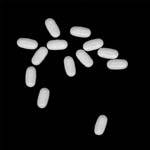|
On
the rise By Sarah McClellan Within five minutes of entering a dance club, Chris (*) can tell who is “rolling” on ecstasy or “X,” a pill that gives the user a euphoric high and has been dubbed a “club drug.” He can also easily tell who is selling it. Within another couple of minutes, Chris, who is a 29-year-old registered nurse at a Dallas/Fort Worth area hospital, can purchase as many “hits” or tablets of ecstasy as he needs to keep his high for the entire evening. The cost is usually between $20 and $25. “It has
become a lot more popular lately,” he said. “It is probably
because it is easy to get, it is cheap and one tablet can last you
all night. Out of three people you ask, at least one will have it.” Chris used ecstasy on a regular basis from when he was 23-years old to when he was 27-years old. Though he said that he doesn’t think the drug is addictive, he stopped using, because he became aware of the consequences involved. “People don’t realize what the consequences are,” Chris said. “They’ll buy it from anyone. It could be someone they’ve never met and will never see again. Anything could happen.” Chris also said the popularity of ecstasy is rising, because it has been brought to the public’s attention through the media. “It’s so much easier to get now and so many more people are doing it, because people are being exposed to it more,” Chris said. “Now when I go to clubs it definitely seems like more people are using it.” Braden Howell, a sophomore premajor, also thinks ecstasy use is rising. “Even my friends who don’t do drugs are trying ‘X,’” Howell said. “Some of them feel like they’re not really doing drugs, because it’s not like heroin or cocaine.” Lt. Ric Clark, commander of the narcotics section of the Fort Worth Police Department, agrees. “That’s what they say when we pick them up,” Clark said. “They say, ‘We’re not out doing heroin or cocaine.’ They say there’s a big difference between ecstasy and other drugs. They don’t see that this is a big deal. But this drug does a lot of brain damage.” Howell also said the drug has become more available in the past year. “It’s in the mainstream now, and a lot more kids are doing it,” Howell said. “The more popular it gets, the more accessible it gets, and the more accessible it gets, the cheaper it gets.” Howell said he has been offered the drug at various bars and clubs more in the past year than before. In a June 5, 2000 government report, Francis E. Seib, acting special agent in charge of the Dallas Field Division of the Drug Enforcement Administration, told the House Subcommittee on Criminal Justice, Drug Policy and Human Resources, “Adolescents in the Dallas area are experimenting with, and abusing, a wide variety of drugs. In particular, the increasing use of drugs, such as ecstasy and methamphetamine, by our youth is quickly becoming one of the most significant law enforcement and social issues facing our nation today.” He said the Dallas Field Division personnel have recently documented the rising popularity of “club drugs,” such as ecstasy, or MDMA, GHB, Ketamine and LSD among young adults. “These drugs are being used ... at all-night raves and nightclubs in Dallas and surrounding areas,” Seib said. “These rave functions, which are parties known for loud techno-music and dancing at underground locations, regularly host several thousand teen-agers and young adults who use MDMA, LSD, GHB, Ketamine and Methamphetamine.” These events, Seib said, are designed to appeal to the teen-age to mid-30 demographic. “It’s a problem with the population going through the rave scene,” said Steven Martin, a case manager at the Tarrant Council on Alcoholism and Drug Abuse. “It’s a popular drug for the time.” Clark said the drug is most popular in the 16 to 20 age bracket. “It’s a club drug type of situation, where different people think it’s all right to do this,” Clark said. Chris said the allure in these “club drugs” is that the high you get from them is different from other drugs. “It’s like a runner’s high times ten, except without doing any work,” he said. “The music going and the lights flashing adds to it. It’s totally different than being drunk, and it’s not like (caffeinated beverages), because it’s not something you get up in the morning and do and then do all your daily activities. You only take it in party situations.” (*) Name has been changed. Sarah
McClellan
|
The TCU Daily Skiff
© 1998, 1999, 2000, 2001
Web Editor: Ben Smithson
Contact Us!

